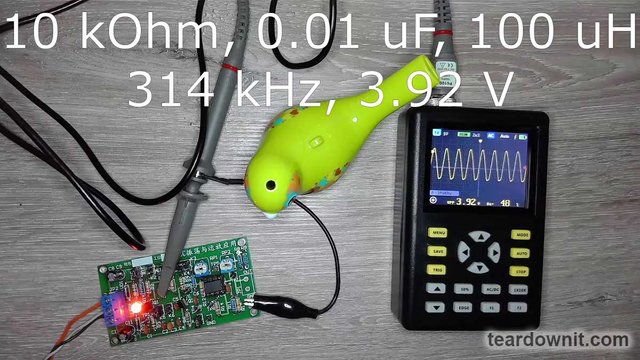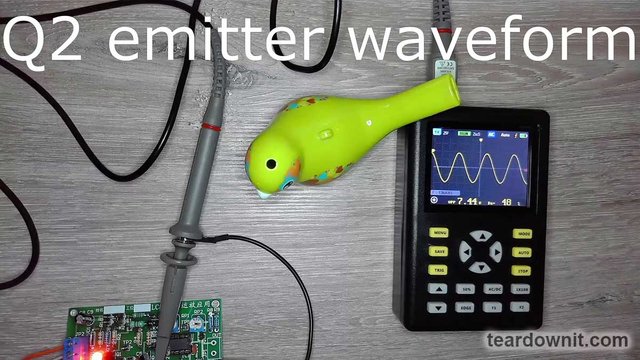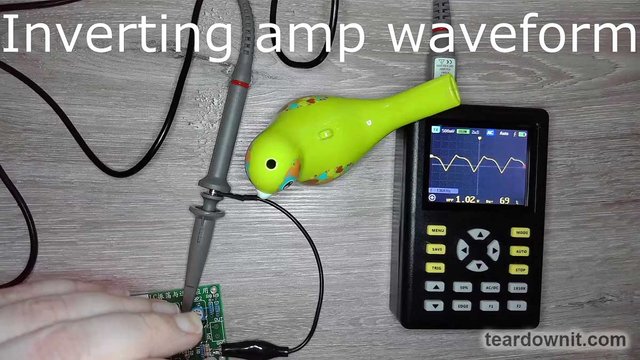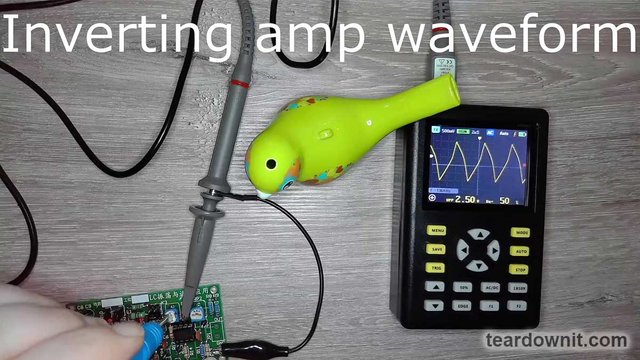The awesome Colpitts oscillator. Exploring the secrets of the Colpitts generator.

Hello, and welcome to our electronic studies! We probably all know that an oscillating circuit consists of a capacitor (C) and an inductor (L), and its waveform is an ideal sine wave.
In the LC resonant circuit, single-frequency oscillations occur, and their period in seconds is equal to 2π√(LC).

This equation is called Thomson's formula after its author, William Thomson, aka 1st Baron Kelvin. Many other things are named after him because Lord Kelvin was an outstanding scientist and inventor. One can recall, for example, the Kelvin, a unit of absolute temperature, or the marine compass with sundial he invented.

Another thing we know is that a transistor and an operational amplifier amplify the signal, meaning they transform a sin wave with a small amplitude into a sine wave with a bigger amplitude. We had 0.5 volts; it became five volts - ten times as much.

However, real electronic devices, even seemingly simple ones made from a handful of components, work in a much more complex and interesting way than the simplified idea of them from a school physics class.
This can either cause problems that we must learn to overcome or inspire technical creativity and help us achieve difficult tasks with simple components.
Today, we will study the operation of a real Colpitts oscillator, and a small printed circuit board and a digital oscilloscope will help us with this.

Edwin Henry Colpitts was a great inventor and a famous communications engineer. From 1897 to 1899, he served at Harvard's Jefferson Physical Laboratory. From 1899 on, Mr. Colpitts worked at the American Bell Telephone Company. In 1907, he became the research branch chief at the Western Electric Company. It was a manufacturing division of the American Telephone and Telegraph Company from 1881 to 1995.

Colpitz became vice president of AT&T in 1924 and was vice president of Bell Labs from 1934 to 1937. From 1940 to 1946, he served as head of technical aid for Division 6 (antisubmarine warfare) of the National Defense Research Committee and was awarded the Medal of Merit.
As often happens among renowned geniuses, Colpitz neglected his most known invention. He described the operating principle of his generator in a private conversation around 1915. He quickly forgot this product pitch, and later, according to company practice, he was asked to sign a patent application in 1918 (US patent 1624537).
A distinctive feature of the Colpitts oscillator is that the positive feedback for the amplifier (which can be a bipolar or field-effect transistor, an operational amplifier, or a vacuum tube) is received from a voltage divider on two capacitors connected in series and connected to an inductor.

The oscillation frequency is nearly equal to the resonant frequency of the LC circuit of two capacitors with an inductor parallel to them.

The actual frequency will differ from the theoretically calculated one due to the distribution of capacitances and the resistive load of the transistor. This is exactly what we will see on the oscilloscope screen.

The twin brother and probable predecessor of the Colpitts generator was the Hartley oscillator; a patent application for it was filed in 1915 (US patent 1356763, issued 1920). The difference is that a voltage divider for positive feedback is formed not by two capacitors but by two inductors in series or a single-tapped inductor.
The innovative feature behind the Hartley oscillator was that its coils did not have to be magnetically coupled, which was strictly necessary for its predecessors, the Meissner and the Armstrong oscillators.

Rhodes Scholarship winner Ralph Vinton Lyon Hartley, also known for pioneering the concept of "information" as a random variable and for attempting to define the "unit of measure of information", has worked for the Western Electric Company since 1915. He was in touch with Edwin Colpitts at the time and probably was a part of the aforementioned discussion on using a capacitive voltage divider instead of an inductive one.
Hartley was awarded the IRE (now IEEE) Medal of Honor for his generator and information proportionality law in 1946. In addition to the oscillator, Hartley transform, and the logarithmic unit of measure for information entropy named after him, he owns more than 70 patents, including a neutralization circuit to eliminate parasitic self-excitation of a triode.

The very first IRE Medal of Honor in history was received by the inventor of the LC continuous oscillation generator with positive feedback (differing from the earlier shock excitation of damped oscillations, like the Hertz generator and Tesla spark transformer).

The idea of positive feedback was also introduced by American electrical engineer and innovator Edwin Howard Armstrong, inventor of the FM radio, superheterodyne and super-regenerative radio receivers, and FM radar. In total, Armstrong filed 42 patents.

The Armstrong oscillator, made in 1912, was an LC resonant tank circuit connected to the input of a tube or transistor amplifier stage. A feedback coil was connected to the output of the cascade.

The generator, invented in 1913 and named after Austrian engineer and physicist Alexander Meissner, was similar to the Armstrong generator; the only difference was that the Meissner LC generator circuit was connected to the output of the amplifier. The coupling coil was connected to the input. These two oscillators were so close that they are now often combined under the general name "Armstrong-Meissner oscillator".
Each of these generators must be carefully tuned to produce a clean sine-wave signal. We will now see this during the experiment. An oscilloscope can show more than a dozen formulas.
In today's experiment, we will make use of a board designed for a middle school experiment. It contains a Colpitts oscillator on transistor Q1, an amplifier stage on transistor Q2, a reversed-phase amplifier on op-amp U1A, and a node on operational amplifier U1B, which can be a comparator or an analog signal amplifier, depending on the setting.

The operational amplifiers are powered by a bipolar ±9-volt power supply. At the same time, the transistor stages only need a unipolar + 9 volts of power.
DC isolation is provided by capacitors C5, C6, and C7, which pass the alternating component and block the direct current one. This way, it is possible to transmit an alternating electrical signal between circuit points with different potentials. This is one of the fundamentals of electronic circuitry.
Capacitor C1 grounds the AC base of transistor Q1, so the cascade operates in common-base mode. Resistor R1 (or R2, we can switch between them using jumpers JP1 and JP2) sets the bias current of the base of the transistor and thus its operating point.
The oscillating circuit coils are switched by jumpers JP3 and JP4, capacitors C2 and C3 by JP5 and JP6.
In total, we have two to the power of three, that is, eight options for jumper positions. Let's start from the very first: close JP1, JP3, and JP5. Next, we will switch one jumper at a time to see the changes at each stage until we've tested all eight possible combinations.
Let's take another look at the formula for the oscillation frequency of the Colpitts generator. The calculated oscillation period is 2π√(0.1 mH * 5 nF) = 4.44 ns. This corresponds to a frequency of 225 kHz.

Inductance L2 exceeds L1 by 4.7 times, which should reduce the frequency by √4.7 = 2.17 times. The capacitance of C3 is 3 times higher than that of C2, so we should expect a decrease in frequency by √(0.75/0.5) = 1.22 times.

Let's connect the oscilloscope to the node TP2 output of the generator. The measured frequency when C = 0.01 uF and L = 100 uH turned out to be 314 kHz; the calculated frequency is 30% lower. The cause could be Chinese-made ceramic disk capacitors; cheap ones tend to have 30–35% less capacity than listed. The oscillation amplitude Vp-p is 3.92 V, while the sinusoid is not ideal with a flattened lower part.

We did not replace either capacitor or inductor; we just switched the transistor base bias resistor from 10 to 220 kOhm. Now we have a beautiful sine wave with an amplitude of 4.44 V. And the most interesting thing here is that the frequency has decreased to 301 kHz.
The fact is that the base bias current changes the conductivity of the transistor and, accordingly, the equivalent capacitance, which defines the resonant frequency of the oscillatory circuit. This property of a transistor LC oscillator will help us build a simple FM radio transmitter.

Switching back to the 10 kOhm resistor, we see the frequency increase to 263 kHz. The amplitude dropped even lower, to 2.28 V, but the sine wave is now flawless: symmetrical and not flattened at the bottom.

Connecting the 470 uH inductor, the amplitude is 2.28 V. The frequency of 121 kHz is exactly 2.17 times lower than 263, which fully corresponds to the formula.

With a 220 kOhm resistor, the frequency dropped to 54.3 kHz. The minus-first harmonic has now become stronger than the design frequency of the generator. So, we got the frequency divided in half, and the fundamental frequency now becomes the first harmonic. The amplitude increased greatly to 4.9 V.

With a 0.01 uF capacitor, the voltage increased to 7.28 V. The sine wave looks right, and the frequency is correct—133 kHz.

With a 10 kOhm resistor, the amplitude dropped to 4.52 V, and the frequency increased to 145 kHz. The lower part of the sine wave is squashed.

To look further into the signal propagation, let's revert to the 220 kΩ resistor because this combination produced a stable and strong signal with an ideal sine wave shape. Now, let's see the distortion caused by the transistor and operational amplifiers.

We see extreme distortion on collector Q2. Not only did full-wave rectification of the signal occur, but a third harmonic, characteristic of transistors, was also added. It shows up as a hump one-third of the period wide. Such odd transistor harmonics are undesirable for the resulting sound, unlike tube harmonics.
Such strong signal distortion is caused by the scheme with a common collector and not with a common collector. If we connected a capacitor in parallel with R6, we would get a common-emitter stage, and the signal at the collector would be much cleaner.

On the contrary, we see an excellent pure sine wave at the emitter because Q1 operates in buffer mode or emitter follower.

Now, let's connect the oscilloscope probe to the output of the first operational amplifier, U1A. And instead of a sinusoid, we see relaxation oscillations, the pattern of which changes depending on the resistance of the trimming resistor RP1 in the feedback loop.

C6 and R7 are differentiator circuits or high-pass filters; their time constant is 1 millisecond. And the period of oscillations at a frequency of 133 kHz is 7.5 microseconds, which is 133 times less. Therefore, this RC chain has almost no effect on the signal flow at this frequency.
Where do the distortions come from, then? We haven't added a small ceramic capacitor parallel to RP1 to the circuit design. Several tens of picofarads of capacitance would've helped suppress the high-frequency resonance of the operational amplifier.

Finally, at the output of U2A, we see either a constant voltage or an almost perfect triangle wave, depending on the resistance of RP2. In the first case, U2A works as a comparator, and in the second, as an amplifier, thanks to the resistor R13 creating negative feedback.

The fact that the Colpitts oscillator frequency depends on the transistor base bias current was used in a small FM radio transmitter that I've assembled and tested. Experiments with it do not violate the laws on radio communications, as its power is extremely low. Transmitters like this are used in older cars to listen to music from a CD or MP3 player through an FM radio that does not have an AUX input.

Q1 amplifies the microphone signal, which then goes to the Q2 base, part of the Clapp oscillator. This is almost the same Colpitts generator, with an added capacitor C8 in series with the coil L4 to improve operating stability.
Q3 works as the output power amplifier. C7, C9, C10, and L3 together are the output filters for frequency matching with the antenna, which is just a piece of wire.
The input jack disconnects the Clapp oscillator from the microphone amplifier and supplies a modulating signal from an external source. For example, a homemade MP3 player, like in my video.
The left channel signal comes through resistor R10, and the right channel comes through resistor R7. This is a mono transmitter. I also plan to assemble a stereophonic modulator and tell you all about it in one of the upcoming posts.